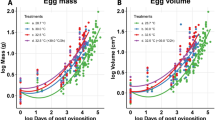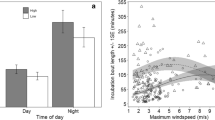Summary
Incubation temperatures in vertebrates affect incubation periods, and in some reptiles incubation temperature determines sex ratios and some limited behavior. Here I present evidence that incubation temperature in pine snakes (Pituophis melanoleucus) affects not only incubation periods and posthatching behavior in the laboratory, but also the behavior of hatchlings required for successful emergence and survival. These behavioral differences have evolutionary implications for selection of hatchlings from particular temperature nests. With increasing temperature, incubation periods decreased in the laboratory. In addition, incubation temperature affected hatching and emergence times as well as movement speed and foraging ability. Hatchlings from medium temperature conditions emerged from nests in the field in less time than hatchlings incubated at high or low temperatures, and hatchlings from low temperatures moved slower and were less able to capture and eat mice in the laboratory than hatchlings incubated at medium or high temperatures. Taken together, these laboratory and field experiments suggest that hatchlings from low temperature nests, compared to those from higher temperature nests, would be less able to emerge, find food, and locate hibernation sites prior to the onset of cold temperatures in the New Jersey Pine Barrens. These results suggest that incubation temperature affects a whole range of behavior and that distributional ranges of reptiles and other poikilotherms could be affected by summer temperatures (via incubation period and subsequent behavior) as well as ambient winter temperatures.
Similar content being viewed by others
References
Bennett AF, Dawson WR (1976) Metabolism. In: Gans AC, Dawson WR (eds) Biology of the reptilia, vol 5, Physiology. Academic Press, New York, pp 127–223
Bull JJ (1980) Sex determination in reptiles. Q Rev Biol 55:4–21
Bull JJ (1985) Sex ratio and nest temperature in turtles: comparing field and laboratory data. Ecology 66:1115–1122
Burger J (1989) Incubation temperature has long-term effects on behaviour of young pine snakes (Pituophis melanoleucus). Behav Ecol Sociobiol 24:201–207
Burger J (1990) Effects of incubation temperature on behavior of young black racers (Coluber constrictor) and kurgsnakes (Lampropeltis gefulus). J Herpetol 24:158–163
Burger J, Zappalorti RT (1986) Nest site selection by pine snakes, Pituophis melanoleucus, in the New Jersey Pine Barrens. Copeia 1:116–121
Burger J, Zappalorti RT (1988) Effects of incubation temperature on sex ratios in pine snakes: differential vulnerability of males and females. Am Nat 132:492–505
Burger J, Zappalorti RT, Gochfeld M (1987) Development effects of incubation temperature on hatchling pine snakes Pituophis melanoleucus. Comp Biochem Physiol 87A:727–732
Burger J, Zappalorti RT, Gochfeld M, Boarman WI, Caffrey M, Doig V, Garber SD, Lauro B, Mikovsky M, Safina C, Saliva J (1988) Hibernacula and summer den sites of pine snakes Pituophis melanoleucus in the New Jersey Pine Barrens. J Herpetol 22:425–433
Caillouet CW, Durouslet MJ Jr (1985) Sea turtle sex ratios and incubation temperature: are we on the right track? Mar Turtle Newslett 35:14–16
Charnier M (1966) Action de la temperature sur la sex-ratio chez l'embryon d'Agama agama (Agamidae, Lacertilien). Soc Biol Quest Afr 160:620–622
Deeming DC, Ferguson MWJ (1989a) Effect of incubation temperature on growth and development of embryos of Alligator mississippiensis. J Comp Physiol B 159:183–193
Deeming DC, Ferguson MWJ (1989b) The mechanism of temperature dependent sex determination in crocodilians: a hypothesis. Am Zool 29:347–383
Ferguson MWJ (1983) Temperature-dependent sex determination in Alligator mississippiensis. J Zool (London) 200:143–177
Ferguson MWJ, Joanen T (1982) Temperature of egg incubation determines sex in Alligator mississippiensis. Nature (London) 296:850–853
Gregory PT (1982) Reptilian hibernation. In: Gans C, Pough FH (eds) Biology of the reptilia, vol 13, Physiology D: physiological ecology. Academic Press, New York, pp 53–154
Gibbons JW, Nelson DH (1978) The evolutionary significance of delayed emergence from the nest by hatchlings turtles. Evolution 32:297–303
Gutzke WHN, Crews D (1988) Embryonic temperature determines adult sexuality in a reptile. Nature 332:832–834
Gutzke WHN, Packard GC (1987a) Influence of the hydric and thermal environments on eggs and hatchlings of bull snakes Pituophis melanoleucus. Physiol Zool 60:9–17
Gutzke WHN, Packard GC (1987b) The influences of temperature on eggs and hatchlings of Blanding's turtles, Emydoidea blandingit. J Herpetol 21:161–163
Gutzke WHN, Paukstis GL (1983) Influence of the hydric environmental on sexual differentiation of turtles. J Exp Zool 226:467–469
Gutzke WHN, Paukstis GL, McDaniel LL (1985) Skewed sex ratios for adult and hatchling bull snakes, Pituophis melanoleucus, in Nebraska. Copeia 1985:649–652
Harkey GA, Semlitsch RD (1988) Effects of temperature on growth, development and color polymorphism in the orante chorus frog Pseudacris ornata. Copeia 1988:1001–1007
Huey RB (1982) Temperature, physiology, and the ecology of reptiles. In: Gans CC, Pough FH (eds) Biology of the reptilia, vol 12; Physiology. Academic Press, New York, pp 25–92
Lang J (1985) Incubation temperature affects thermal selection of hatchling crocodiles. Am Zool 25:16
Lang J (1987) Crocodelian thermal selection. In: Webbs GJW, Manolis SC, Whitehead PJ (eds) Wildlife management: crocodiles and allegators. Surry, Baetty and Sons, London, pp 301–307
Lang JW, Andrews H, Whitaker R (1989) Sex determination and sex ratios in Crocodylus palustris. Am Zool 29:935–952
Londos PL, Brooks RJ (1988) Effect of temperature acclimation on locomotory performance curves in the toad Bufo woodhousii woodhousii. Copeia 1988:26–32
Morreale SJ, Ruiz GJ, Spotila JR, Standora EA (1982) Temperature-dependent sex determination: current practices threaten conservation of sea turtles. Science 216:1245–1247
Muth A (1980) Physiological ecology of desert iguana (Dipsosaurus dorsalis) eggs: temperature and water relations. Ecology 61:1335–1343
Naulleau G (1983) The effects of temperature on digestion in Vipera aspis. J Herpetol 17:166–170
Packard GC, Packard MJ (1986) Hydric conditions during incubation influence locomotor performance of hatchling snapping turtles. J Exp Biol 127:401–412
Packard GC, Taigen TL, Boardman TJ, Packard MJ, Tracy CR (1979) Changes in mass of softshell turtle (Trionyx spiniferus) eggs incubated on substrates differing in water potential. Herpetologica 35:780–786
Packard MJ, Packard GC, Boardman TJ (1982) Structure of eggshells and water relations of reptilian eggs. Herpetologica 38:136–155
Packard MJ, Boardman TJ, Morris KA, Shuman RD (1983) Influence of water exchanges by flexible-shelled eggs of painted turtles Chrysemys picata on metabolism and growth and embryos. Physiol Zool 56:217–230
Plummer MV, Snell HL (1988) Nest site selection and water relation of eggs in the snake, Opheodrys aestivus. Copeia 1988:58–64
Tracy CR (1980) Water relations of parchment-shelled lizard (Sceloporus undulatus) eggs. Copeia 1980:478–482
Vincent TK, Secoy DM (1978) The effects of annual variation in temperature on cold resistance in a Northern population of the red-sidded garter snake, Thamnophis sirtalis parietalis (Reptilia, Serpentes, Colubridae). J Herpetol 12:291–294
Vinegar A (1974) Evolutionary implication of temperature induced anomalie of development in snake embryos. Herpetologica 30:73–74
Webb GJW, Cooper-Preston H (1989) Effects of incubation temperature on crocodiles and the evolution of reptilian oviparitis. Am Zool 29:953–971
Webb GJW, Smith A (1984) Sex ratio and survivorship in the Australian freshwater crocodile Crocodylus johnstoni. Symp Zool Soc Lond 52:319–355
Whittier JM, Mason RT, Crews D (1987) Role of light and temperature in the regulation of reproduction in the red-sided garter snake, Thamnophis sirtalis parietalis. Can J Zool 65:2090–2096
Yntema CL (1976) Effects of incubation temperature on sexual differentiation in the turtle Chelydra serpentina. J Morphol 150:453–462
Yntema CL (1979) Temperature levels and periods of sex determination during incubation of eggs of Chelydra serpentina. J Morphol 159:17–27
Yntema CL (1982) Critical periods and pivotal temperatures for sexual differentiation in loggerhead sea turtles. Can J Zool 60:1012–1016
Zappalorti RT, Johnson EW, Leszozynski Z (1983) The ecology of the northern pine snakes, Pituophis melanoleucus melanoleucus (Daudin) (Reptilia, Serpentes, Colubridae) in southern New Jersey with special notes on habitat and nesting behavior. Bull Chicago Herpetol Soc 18:57–72
Author information
Authors and Affiliations
Rights and permissions
About this article
Cite this article
Burger, J. Effects of incubation temperature on behavior of hatchling pine snakes: implications for reptilian distribution. Behav Ecol Sociobiol 28, 297–303 (1991). https://doi.org/10.1007/BF00175103
Received:
Accepted:
Issue Date:
DOI: https://doi.org/10.1007/BF00175103




